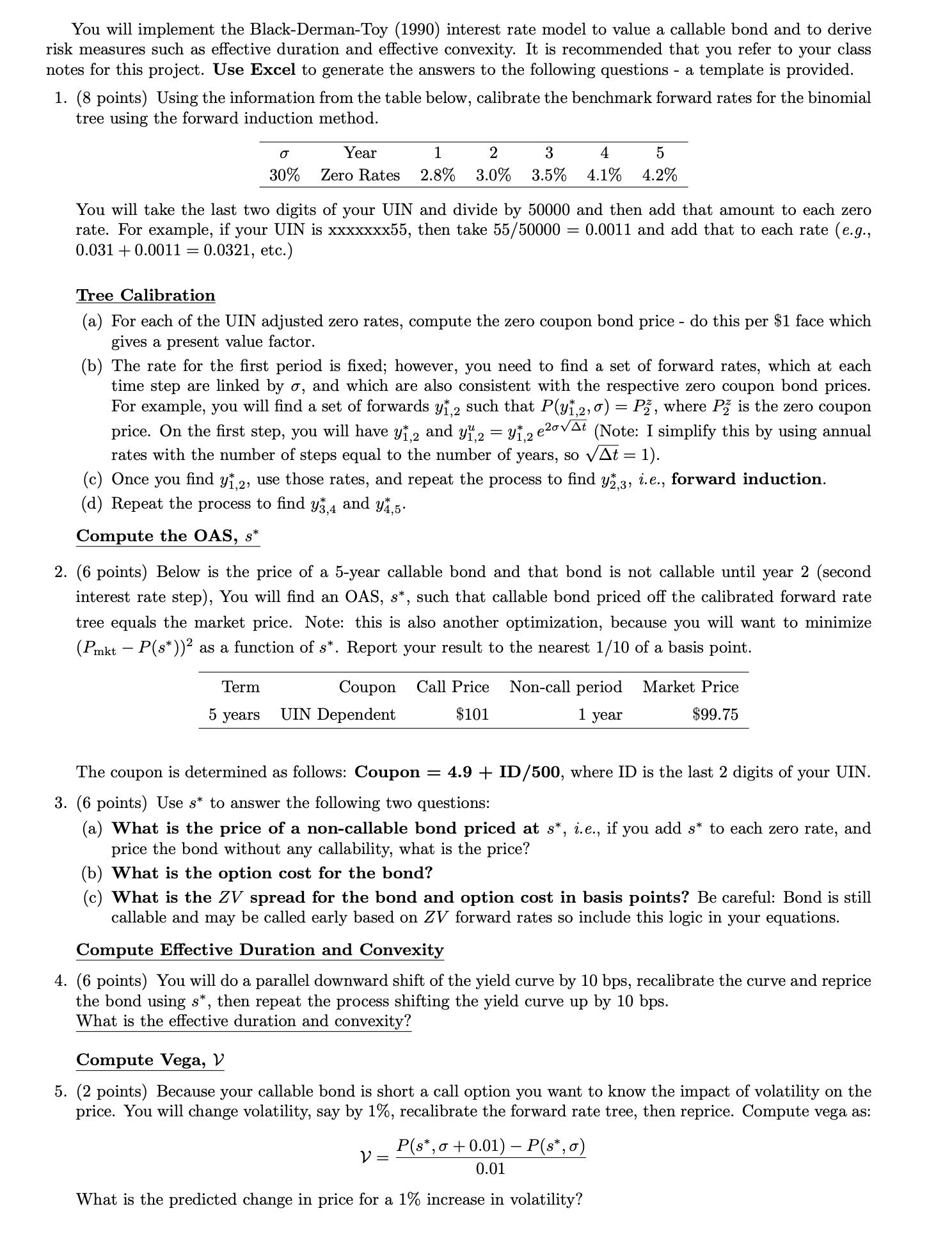Answered step by step
Verified Expert Solution
Question
1 Approved Answer
You will implement the Black-Derman-Toy (1990) interest rate model to value a callable bond and to derive risk measures such as effective duration and

You will implement the Black-Derman-Toy (1990) interest rate model to value a callable bond and to derive risk measures such as effective duration and effective convexity. It is recommended that you refer to your class notes for this project. Use Excel to generate the answers to the following questions - a template is provided. 1. (8 points) Using the information from the table below, calibrate the benchmark forward rates for the binomial tree using the forward induction method. 30% Year 1 2 Zero Rates 2.8% 3.0% You will take the last two digits of your UIN and divide by 50000 and then add that amount to each zero rate. For example, if your UIN is xxxxxxx55, then take 55/50000 0.0011 and add that to each rate (e.g., 0.031 +0.0011 = 0.0321, etc.) 3 4 5 3.5% 4.1% 4.2% Tree Calibration (a) For each of the UIN adjusted zero rates, compute the zero coupon bond price - do this per $1 face which gives a present value factor. Term 5 years (b) The rate for the first period is fixed; however, you need to find a set of forward rates, which at each time step are linked by o, and which are also consistent with the respective zero coupon bond prices. For example, you will find a set of forwards y1,2 such that P(y1,2,0) = P2, where P is the zero coupon price. On the first step, you will have y1,2 and y1,2 = y,2 e0At (Note: I simplify this by using annual rates with the number of steps equal to the number of years, so At = 1). = (c) Once you find y,2, use those rates, and repeat the process to find y2,3, i.e., forward induction. (d) Repeat the process to find y3,4 and y4,5. Compute the OAS, s* 2. (6 points) Below is the price of a 5-year callable bond and that bond is not callable until year 2 (second interest rate step), You will find an OAS, s*, such that callable bond priced off the calibrated forward rate tree equals the market price. Note: this is also another optimization, because you will want to minimize (Pmkt - P(s*)) as a function of s*. Report your result to the nearest 1/10 of a basis point. Coupon UIN Dependent Call Price Non-call period Market Price $101 1 year $99.75 The coupon is determined as follows: Coupon = 4.9 + ID/500, where ID is the last 2 digits of 3. (6 points) Use s* to answer the following two questions: (a) What is the price of a non-callable bond priced at s*, i.e., if you add s* to each zero rate, and price the bond without any callability, what is the price? (b) What is the option cost for the bond? (c) What is the ZV spread for the bond and option cost in basis points? Be careful: Bond is still callable and may be called early based on ZV forward rates so include this logic in your equations. V = Compute Effective Duration and Convexity 4. (6 points) You will do a parallel downward shift of the yield curve by 10 bps, recalibrate the curve and reprice the bond using s*, then repeat the process shifting the yield curve up by 10 bps. What is the effective duration and convexity? your UIN. Compute Vega, V 5. (2 points) Because your callable bond is short a call option you want to know the impact of volatility on the price. You will change volatility, say by 1%, recalibrate the forward rate tree, then reprice. Compute vega as: P(s*, o +0.01) P(s*, 0) 0.01 What is the predicted change in price for a 1% increase in volatility?
Step by Step Solution
There are 3 Steps involved in it
Step: 1

Get Instant Access to Expert-Tailored Solutions
See step-by-step solutions with expert insights and AI powered tools for academic success
Step: 2

Step: 3

Ace Your Homework with AI
Get the answers you need in no time with our AI-driven, step-by-step assistance
Get Started


